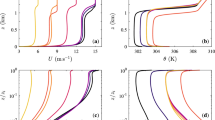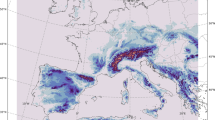Summary
Hydrostatic and nonhydrostatic simulation models are employed to study the intensification of a terrain drag-induced dryline. The study develops a multi-stage theory for the evolution of the dryline including the concentration of potential vorticity accompanying meso-gamma scale dryline “bulges”.
The numerical simulations indicate three fundamental stages of dryline intensification all of which are either directly or indirectly a result of the terrain-drag on the mid/upper-tropospheric jet stream by the Front Range of the Colorado Rocky Mountains. The first stage involves the downward momentum flux accompanying a large amplitude hydrostatic mountain wave which induces a downslope windstorm along the lee slopes. The surge of momentum (i.e., the dry, warm air associated with the downslope windstorm) propagates down the leeslope and modifies an existing weak dryline boundary. As the downslope windstorm initiates an undular bore along the lee slopes, the high momentum gradient which propagates downstream accompanying the bore, as well as the strong lower tropospheric sinking motions ahead of the bore, contract the scale of the surface moisture boundary between the dry air from above the leeslope and the moist air over the High Plains. This process further strengthens the dryline.
The second stage involves the coupling of the terrain drag-induced along-stream ageostrophic front within the midtroposphere to the boundary layer through a thermally-indirect circulation. As the along-stream ageostrophic circulation intensifies within the middle troposphere down-stream from the mountain wave, sinking air parcels originating above 40 kPa descend to below 60 kPa over the High Plains where surface pressures are, only ∼85 kPa. These descending air parcels within the upstream branch of the along-stream ageostrophic thermally-indirect circulation contain high values of momentum and very low dewpoint values. As the planetary boundary layer (PBL) deepens due to surface warming during the morning hours, momentum and dry air from the midtropospheric along-stream ageostrophic front are entrained into the PBL. This process amplifies the bore-induced hydrostatic dryline bulge via low-level ageostrophic confluence.
Finally, regions of low Richardson number (arising from strong vertical shears) within the amplifying midtropospheric along-stream ageostrophic thermally-indirect circulation become preferred regions for the development of non-hydrostatic evanescent internal gravity waves. These waves are embedded within the hydrostatic along-stream front above the low-level dryline and are accomapanied by very significant values of vertical momentum flux which act to focus the meso-gamma scale structure of the dryline into smaller scale bulges where low-level winds and vorticities are very high. This meso-gamma scale process follows the hydrostatic tilting and vortex tube stretching which creates meso-beta scale maxima of mid-lower tropospheric vorticity. The turbulent momentum fluxes accompanying wavebreaking within the nonhydrostatic dryline bulge create very large (i.e., stratospheric values of) potential vorticity near 70 kPa due to the nonconservation of potential vorticity on isentropic surfaces.
Similar content being viewed by others
References
Gram, J. M., Kaplan, M. L., Mattocks, C. A., Zack, J. W., 1991: The analysis and use of profiler winds to derive mesoscale height and temperature fields; simulation and real data experiments.Mon. Wea. Rev.,119, 1041–1056.
Ertel, H., 1942: Ein neuer hydrodynamischer Wirbelsatz.Meteor. Z.,359, 277–281.
Gidel, L. T., Shapiro, M. A., 1979: The role of clear air turbulence in the production of potential vorticity in the vicinity of upper tropospheric jet stream-frontal systems.J. Atmos. Sci.,36, 2125–2138.
Haltiner, G. J., Martin, F. L., 1957:Dynamical and Physical Meteorology New York: McGraw-Hill, 470 pp.
Kaplan, M. L., Karyampudi, V. M., 1992a: The influence of the Rocky Mountains in the 13–14 April 1986 severe weather outbreak. Part III: Three-dimensional numerical simultions of a terrain drag-induced lee cyclogenesis and a transient bore.Mon. Wea. Rev. (submitted).
Kaplan, M. L., Karyampudi, V. M., 1992b: The influence of the Rocky Mountains in the 13–14 April 1986 severe weather outbreak. Part IV: Three-dimensional numerical simulations of an internal gravity wave and ageostrophic along-stream secondary circulationMon. Wea. Rev. (submitted).
Kaplan, M. L., Karyampudi, V. M., 1992c: Meso-beta scale numerical simulations of terrain drag-induced along-stream circulations. Part I: Midtropospheric frontogenesis.Meteorol. Atmos. Phys.,49, 133–156.
Karyampudi, V. M., Kaplan, M. L., Koch, S. E., 1992a: The influence of the Rocky Mountains in the 13–14 April 1986 severe weather outbreak. Part I: Formation of a mesoscale tropopause fold and its relationship to severe weather and dust storms.Mon. Wea. Rev. (submitted).
Karyampudi, V. M., Bacmeister, J. T., Koch, S. E., Rottman, J. W., Kaplan, M. L., 1992b: The influence of the Rocky Mountains in the 13–14 April 1986 severe weather outbreak. Part II: Generation of an undular bore and its role in triggering severe weather.Mon. Wea. Rev. (submitted).
Keyser, D., Shapiro, M. A., 1986: A review of the structure and dynamics of upper-level frontal zones.Mon. Wea. Rev.,114, 452–499.
Koch, S. E., 1979: Mesoscale gravity waves as a possible trigger of severe convection along a dryline. Ph.D. Thesis, University of Oklahoma, Norman, Oklahoma, 195 pp.
Koch, S. E., McCarthy, J., 1982: The evolution of an Oklahoma dryline. Part II: Boundary layer forcing of mesoconvective systems.J. Atmos. Sci.,39, 237–257.
McGinley, J., 1973: Environmental energy fields associated with severe storms. M.S. Thesis, University of Oklahoma, Norman, Oklahoma, 130 pp.
Nieman, P. J., Hardesty, R. M., Shapiro, M. A., Kupp, R. E., 1988: Doppler lidar observations of a downslope windstorm.Mon. Wea. Rev.,116, 2265–2275.
Proctor, F. H., 1987a: The terminal area simulation system. Volume I: Theoretical formulation. NASA Contractor Rep. 4046, NASA, Washington, D.C., 176 pp.
Procter, F. H., 1987b: The terminal area simulation system. Volume II: Verification experiments. NASA Contractor Rep. 4047, NASA, Washington, D. C., 112 pp.
Sasaki, Y., 1973: Machanism of squall-line formation as suggested from variational analysis of hourly surface observations. Preprints, Eighth Conference on Severe Local Storms, Denver, Colorado, Amer. Meteor. Soc., 300–307.
Shapiro, M. A., 1978: Further evidence of the mesoscale and turbulent structure of upper-level jet stream-frontal zone systems.Mon. Wea. Rev.,106, 1100–1111.
Tegtmeier, S. A., 1974: The role of the surface subsynoptic low pressure system in severe weather forecasting. M.S. Thesis, University of Oklahoma, Norman, Oklahoma, 65 pp.
Author information
Authors and Affiliations
Additional information
With 30 Figures
Rights and permissions
About this article
Cite this article
Kaplan, M.L., Karyampudi, V.M. Meso-beta scale numerical simulations of terrain drag-induced along-stream circulations. Part II: Concentration of potential vorticity within dryline bulges. Meteorl. Atmos. Phys. 49, 157–185 (1992). https://doi.org/10.1007/BF01025406
Received:
Revised:
Issue Date:
DOI: https://doi.org/10.1007/BF01025406




